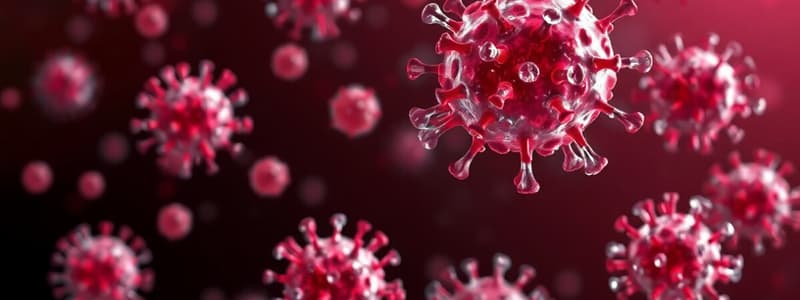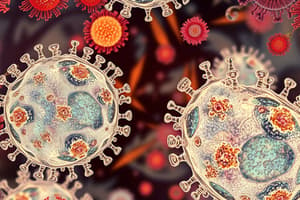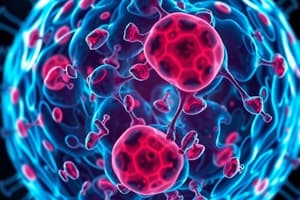Podcast
Questions and Answers
What type of antigens lead to T-cell independent activation of B-cells?
What type of antigens lead to T-cell independent activation of B-cells?
- Polysaccharide antigens
- Thymus-independent antigens (correct)
- Thymus-dependent antigens
- Protein antigens
What characteristic do the epitopes of T-cell independent antigens typically have?
What characteristic do the epitopes of T-cell independent antigens typically have?
- They are irregularly spaced on pathogen surfaces.
- They are exclusively found in soluble forms.
- They are complex and highly variable.
- They occur in dense and regular arrays. (correct)
What role do follicular dendritic cells play in the B-cell area?
What role do follicular dendritic cells play in the B-cell area?
- They store intact antigens and display them to B-cells. (correct)
- They produce antibodies for B-cells.
- They inhibit B-cell activation.
- They activate T-cells directly.
What mechanism allows for the stimulation of B-cell proliferation and differentiation without T cells?
What mechanism allows for the stimulation of B-cell proliferation and differentiation without T cells?
In which B-cell population is T-cell independent activation predominantly seen?
In which B-cell population is T-cell independent activation predominantly seen?
What is a requirement for B cell activation?
What is a requirement for B cell activation?
Which component is part of the B-cell receptor complex?
Which component is part of the B-cell receptor complex?
What initiates a cascade of intracellular signals in B cells?
What initiates a cascade of intracellular signals in B cells?
How does naïve B cell activation occur through a TFH?
How does naïve B cell activation occur through a TFH?
What is the consequence of being unable to form germinal centers?
What is the consequence of being unable to form germinal centers?
What is the primary function of the B cell co-receptor?
What is the primary function of the B cell co-receptor?
Where does somatic hypermutation and affinity maturation occur after B cell activation?
Where does somatic hypermutation and affinity maturation occur after B cell activation?
What drives B cell activation, differentiation, and isotype switching?
What drives B cell activation, differentiation, and isotype switching?
What role does CR2 play in the B cell activation process?
What role does CR2 play in the B cell activation process?
Which statement accurately describes the interaction between BCR and soluble antigens?
Which statement accurately describes the interaction between BCR and soluble antigens?
What initiates the phosphorylation of the cytoplasmic tail of CD19?
What initiates the phosphorylation of the cytoplasmic tail of CD19?
Why do naive B cells require help from CD4 TFH cells?
Why do naive B cells require help from CD4 TFH cells?
What is one consequence of BCR binding to antigen?
What is one consequence of BCR binding to antigen?
How does the structure of CR2 facilitate its function?
How does the structure of CR2 facilitate its function?
In what form does a naive B cell recognize an antigen?
In what form does a naive B cell recognize an antigen?
What is a key factor for B cell-mediated immunity during primary immune responses?
What is a key factor for B cell-mediated immunity during primary immune responses?
What role do follicular dendritic cells (FDCs) play in the recognition of antigens by naive B cells?
What role do follicular dendritic cells (FDCs) play in the recognition of antigens by naive B cells?
How are antigens with C3d brought to lymph nodes for B cell recognition?
How are antigens with C3d brought to lymph nodes for B cell recognition?
What process occurs after antigen activation of B cells in the lymph node?
What process occurs after antigen activation of B cells in the lymph node?
What is the specific interaction that stabilizes the synapse between TFH cells and B cells?
What is the specific interaction that stabilizes the synapse between TFH cells and B cells?
What type of immunoglobulin do plasma cells primarily secrete upon activation?
What type of immunoglobulin do plasma cells primarily secrete upon activation?
What role does CD40L play in the interaction between TFH cells and B cells?
What role does CD40L play in the interaction between TFH cells and B cells?
Which cellular structure is involved in the reorientation of the cytoskeleton during B-cell activation?
Which cellular structure is involved in the reorientation of the cytoskeleton during B-cell activation?
What is the primary location of clonal expansion for B cells in the lymph nodes?
What is the primary location of clonal expansion for B cells in the lymph nodes?
What is the function of the cytoskeleton during the interaction between B cells and TFH cells?
What is the function of the cytoskeleton during the interaction between B cells and TFH cells?
What are the key molecules that are involved in the delivery of cytokines from TFH cells to B cells?
What are the key molecules that are involved in the delivery of cytokines from TFH cells to B cells?
What is the primary location where B cells undergo affinity maturation and isotype switching?
What is the primary location where B cells undergo affinity maturation and isotype switching?
Which type of cell drives somatic hypermutation in centroblasts within the germinal center?
Which type of cell drives somatic hypermutation in centroblasts within the germinal center?
What happens to centrocytes whose B cell receptors (BCRs) peak in affinity for antigen?
What happens to centrocytes whose B cell receptors (BCRs) peak in affinity for antigen?
What is a major role of cytokines produced by TFH cells in the immune response?
What is a major role of cytokines produced by TFH cells in the immune response?
Which of the following cells represent mature non-dividing B cells in the germinal center?
Which of the following cells represent mature non-dividing B cells in the germinal center?
What is the consequence for centrocytes that experience mutations reducing their affinity for antigen?
What is the consequence for centrocytes that experience mutations reducing their affinity for antigen?
Which cytokine is recognized as the most potent inducer of terminal B-cell differentiation in humans?
Which cytokine is recognized as the most potent inducer of terminal B-cell differentiation in humans?
In the germinal center, what are centroblasts primarily responsible for?
In the germinal center, what are centroblasts primarily responsible for?
What role do follicular dendritic cells (FDCs) play in the germinal center?
What role do follicular dendritic cells (FDCs) play in the germinal center?
Which of the following is NOT a consequence of the interaction between centrocytes and TFH cells?
Which of the following is NOT a consequence of the interaction between centrocytes and TFH cells?
Which part of the germinal center do centrocytes primarily occupy?
Which part of the germinal center do centrocytes primarily occupy?
What is the fate of centrocytes that undergo successful affinity maturation?
What is the fate of centrocytes that undergo successful affinity maturation?
Which process occurs within the germinal center as B cells undergo selection?
Which process occurs within the germinal center as B cells undergo selection?
What allows for the generation of diverse antibodies in B cells?
What allows for the generation of diverse antibodies in B cells?
The return of cognate pairs to the primary follicle primarily leads to the formation of what structure?
The return of cognate pairs to the primary follicle primarily leads to the formation of what structure?
What is a key characteristic of self-reactive B cell receptors?
What is a key characteristic of self-reactive B cell receptors?
At what stage do B cells exhibit increased specificity and affinity for antigens?
At what stage do B cells exhibit increased specificity and affinity for antigens?
Which statement accurately describes the role of T cells in B cell activation?
Which statement accurately describes the role of T cells in B cell activation?
What occurs after the negative selection phase for B cells?
What occurs after the negative selection phase for B cells?
Why is affinity maturation important in B cell responses?
Why is affinity maturation important in B cell responses?
What happens to immature B cells that do not react to self antigens?
What happens to immature B cells that do not react to self antigens?
What is the primary difference in negative selection between B cells and T cells?
What is the primary difference in negative selection between B cells and T cells?
What is the result of positive selection for B cells during their development?
What is the result of positive selection for B cells during their development?
Which of the following mechanisms allows B cells to modify their B cell receptors if they react to self antigens?
Which of the following mechanisms allows B cells to modify their B cell receptors if they react to self antigens?
How do B cells that respond to self antigens compare to T cells in terms of selection?
How do B cells that respond to self antigens compare to T cells in terms of selection?
In terms of B cell development, what characterizes immature B cells?
In terms of B cell development, what characterizes immature B cells?
What is the fate of B cells that strongly react with self antigens during development?
What is the fate of B cells that strongly react with self antigens during development?
What happens to B cells that bind to monovalent self-antigens during the selection process?
What happens to B cells that bind to monovalent self-antigens during the selection process?
Which statement best describes receptor editing in B cells?
Which statement best describes receptor editing in B cells?
How does the process of T cell selection differ from B cell selection?
How does the process of T cell selection differ from B cell selection?
What role does the lymphoid tissue play in the life cycle of mature B cells?
What role does the lymphoid tissue play in the life cycle of mature B cells?
What is a characteristic feature of B cells before they leave the bone marrow?
What is a characteristic feature of B cells before they leave the bone marrow?
Flashcards are hidden until you start studying
Study Notes
B-cell Activation
- B-cell activation requires cross-linking of the B-cell receptor (BCR).
- The BCR complex consists of monomeric IgM bound to antigen, along with Igα and Igβ chains for intracellular signaling.
- Multivalent antigens with regularly arrayed epitopes on pathogen surfaces can bind to IgM and cluster BCRs.
- B-cell co-receptors, like CD19, synergize with BCR signaling.
- Cross-linking of BCR and co-receptor increases the strength and efficiency of intracellular signaling.
- Soluble antigens tagged with C3d can also activate B cells by cross-linking BCR and co-receptor.
B-cell Activation with T-cell Help
- Effective B-cell mediated immunity often requires help from CD4+ T follicular helper (TFH) cells.
- Naive B cells internalize antigen, process it, and present it to T cells via MHC class II.
- TFH cells recognize pathogen-derived peptides presented by MHC class II on B cells, leading to B cell activation.
- TFH cells synthesize CD40 ligand (CD40L) which interacts with B-cell CD40 receptors.
- TFH cells secrete cytokines like IL-21, which further contributes to B-cell activation.
B-cell Independent Activation
- T-cell independent activation of B cells (TI) occurs primarily in B-1 cells.
- TI antigens typically have dense and regular arrays of epitopes on pathogen surfaces, leading to strong BCR clustering and activation.
- TI activation does not require T-cell help, as the dense clustering of BCRs provides sufficient signaling.
Follicular Dendritic Cells (FDCs)
- FDCs in the B-cell area store intact antigens and display them to B cells.
- FDCs act as antigen-presenting cells for B-cell activation.
- FDCs express complement receptors (CR2) that bind antigens tagged with C3d.
- This tethering of antigens to FDCs facilitates their presentation to naive B cells.
B-cell Migration and Primary Focus
- Antigen-activated B cells move to the T-cell area to find a TFH cell.
- Activated B and TFH cells, forming a cognate pair, move to the medullary cords.
- This area is known as the primary focus of B-cell expansion.
- During this primary focus, B cells undergo clonal expansion and differentiation into IgM-secreting plasma cells.
Germinal Centers and Secondary Focus
- Some B cells from the primary focus return to the follicle, forming a germinal center.
- The germinal center represents the secondary focus of B-cell expansion.
- Germinal centers are sites where B cells undergo affinity maturation and isotype switching.
Germinal Center Anatomy
- Germinal centers are specialized microenvironments within the primary follicle.
- They are composed of rapidly dividing B cells called centroblasts, which form the dark zone.
- As centroblasts mature, they become non-dividing centrocytes, which form the light zone.
- FDCs in the light zone present antigens to centrocytes.
- TFH cells are present in the light zone and contribute to antigen-mediated selección of centrocytes.
Affinity Maturation
- Somatic hypermutation introduces mutations in the BCR genes of centroblasts.
- Centrocytes with BCRs that exhibit increased affinity for the antigen survive, while those with decreased affinity undergo apoptosis.
- This process drives affinity maturation of the B-cell response.
Isotype Switching
- TFH cells secrete cytokines that guide B-cell isotype switching.
- IL-4 promotes switching to IgE.
- IFN-γ promotes switching to IgG.
- IL-5 promotes switching to IgA.
- IL-10 and IL-21 promote both plasma cell and memory B cell differentiation.
Plasma Cell and Memory B Cell Differentiation
- TFH cells contribute to the differentiation of activated B cells into either plasma cells or memory B cells.
- IL-10 and IL-21 drive the differentiation process.
Ellen Vitetta
- Ellen Vitetta is a prominent immunologist who made significant contributions to our understanding of B-cell biology.
B cell negative selection
- B cells are selected against if they react to self‐antigen, removing any cells that react to self‐antigen.
- Cells that react to self-antigen are retained in the bone marrow, which contrasts with T cells where cells are killed directly.
B cell positive selection
- B cells are selected for if they can bind to antigen directly.
- T cells are also positively selected, but this occurs based on their ability to recognize self molecules.
- B cells go through negative selection before positive selection, whereas T cells go through positive selection before negative selection.
- After positive selection, B cells that can bind to antigen are allowed to leave the bone marrow and circulate in the blood.
B cell receptor editing
- If a B cell reacts to self-antigen, the B cell receptor can be edited to change its specificity.
B cell types
- B2 cells are the most common type and they are active in the immune response.
- B2 cells have a broad range of epitopes that they can recognize due to the rearrangement of their heavy and light chains during development.
- B2 cells respond more quickly to repeated exposure to an antigen due to a process called affinity maturation.
- Changes in immunoglobulin isotypes can happen due to a process called isotype switching.
- B2 cells are responsible for the formation of memory B cells.
Phases of development
- The first phase of B cell development is defined by the process of receptor editing and focuses on selection processes.
- The process of receptor editing happens before positive selection.
- The second phase of development happens in secondary lymphoid tissues.
- The third phase of development happens in the periphery.
B cell maturation
- Immature B cells express IgM and leave the bone marrow.
- Mature B cells express both IgM and IgD.
- B cells circulate in the blood and lymph.
- They will re-enter secondary lymphoid tissues to initiate an immune response.
Studying That Suits You
Use AI to generate personalized quizzes and flashcards to suit your learning preferences.




